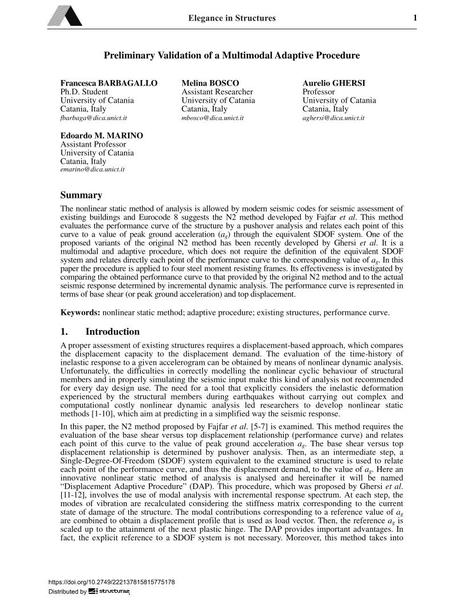Preliminary Validation of a Multimodal Adaptive Procedure

|
|
|||||||||||
Détails bibliographiques
| Auteur(s): |
Francesea Barbagallo
Melina Bosco Aurelio Ghersi Edoardo M. Marino |
||||
|---|---|---|---|---|---|
| Médium: | papier de conférence | ||||
| Langue(s): | anglais | ||||
| Conférence: | IABSE Conference: Elegance in structures, Nara, Japan, 13-15 May 2015 | ||||
| Publié dans: | IABSE Conference Nara 2015 | ||||
|
|||||
| Page(s): | 320-321 | ||||
| Nombre total de pages (du PDF): | 8 | ||||
| Année: | 2015 | ||||
| DOI: | 10.2749/222137815815775178 | ||||
| Abstrait: |
The nonlinear static method of analysis is allowed by modern seismic codes for seismic assessment of existing buildings and Eurocode 8 suggests the N2 method developed by Fajfar et al. This method evaluates the performance curve of the structure by a pushover analysis and relates each point of this curve to a value of peak ground acceleration (ag) through the equivalent SDOF system. One of the proposed variants of the original N2 method has been recently developed by Ghersi et al. It is a multimodal and adaptive procedure, which does not require the definition of the equivalent SDOF system and relates directly each point of the performance curve to the corresponding value of ag. In this paper the procedure is applied to four steel moment resisting frames. Its effectiveness is investigated by comparing the obtained performance curve to that provided by the original N2 method and to the actual seismic response determined by incremental dynamic analysis. The performance curve is represented in terms of base shear (or peak ground acceleration) and top displacement. |
||||
| Mots-clé: |
structures existantes
|
||||
